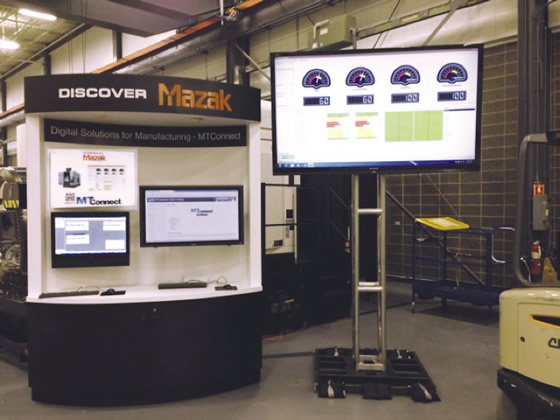While the U.S. greenback has markedly appreciated in the last year, the Boston Consulting Group’s Global Manufacturing Cost-Competitiveness Index shows that the U.S. remains one of the lowest-cost locations for manufacturing in the developed world. Productivity increases are largely responsible, and a key factor in this success is a relentless push to data-driven manufacturing.
Top-flight manufacturers understand that a convergence of connectivity, analytics and ubiquitous Internet devices creates opportunity for an industrial-strength, shop-floor-to-top-floor communications platform that provides real-time efficiency metrics. Specifically, a software-based machine monitoring platform should:
Machine monitoring allows plant managers to cost-effectively isolate productivity issues so everyone from the CEO to each individual machine operator can understand what must be done to maximize efficiency.
Mazak Corp. is a machine tool builder that leads by example. One offering is a 5-axis multitask machine, which the company produces at a rate of 200 units per month at its 800,000-sq.-ft. North American headquarters in Florence, Ky. Mazak’s quest for productivity gains lead to a search to improve manufacturing efficiency, particularly in regards to machine availability and associated downtime.

Mazak demonstrates the MERLIN shop-floor-to-top-floor communications platform and MTConnect at a recent Mazak conference. Image courtesy Memex.
Mazak’s IT department started the efficiency drive by implementing the MTConnect protocol to accurately determine machine availability by using OEE as a standard measurement.
Brian Papke, Mazak’s CEO, personally drove the project to show the machine tool industry the importance of moving toward data-driven manufacturing.
Mazak wanted a platform that could produce meaningful reports that production and management teams could act upon. The company formed a task force to evaluate commercially available software solutions, and, after an exhaustive search, Mazak selected the MERLIN platform from MEMEX Inc.
Mazak chose the platform for its ability to collect data using MTConnect adapters for newer machines and through its Universal Machine Interface circuit board for legacy machines. This advanced adapter board directly captures signals from a legacy machine and translates it into MTConnect-standard code. This combination means every machine on the shop floor is MTConnect-compatible for a common technology analysis platform. Mazak displays and reports on information related to downtime and answer questions, for example, about why a machine isn’t running and what can be done to get it running.
With connected machine monitoring software collecting and reporting Mazak’s production data in real time, Mazak’s cross-functional task force achieved its goal. Following the axiom “you are what you measure,” data-driven manufacturing made an almost instant impact. A series of 60 " monitors presents real-time utilization data. The displays cycle through a series of reports that are viewable for a short period of time. The majority of the reports focus on a specific machine, as well as performance-based gages and readouts, which resemble a car’s speedometer. Other reports present graphs that compare all of the machines connected based on various critical metrics, such as uptime and stoppages by category.
For the first time, top management and shop floor personnel have access to the same actionable information. “Almost as soon as we had the reports out on the plant floor, we saw a 6 percent increase in utilization,” said Ben Schawe, Mazak’s vice president of manufacturing. “This was true low-hanging fruit. Without doing anything else—just making our operators aware of how their time management affected machine utilization—we got dramatic payback.”
Schawe said related efforts to reduce downtime have improved OEE for the monitored machines 42 percent. In addition, Mazak reduced operator overtime by 100 hours per month, and 400 hours per month of previously outsourced work was returned to the company. CTE
 About the Author: David McPhail is president and CEO of MEMEX Inc., Burlington, Ont. For more information about the company’s MERLIN communications platform, visit www.memexautomation.com or call (866) 573-3895.
About the Author: David McPhail is president and CEO of MEMEX Inc., Burlington, Ont. For more information about the company’s MERLIN communications platform, visit www.memexautomation.com or call (866) 573-3895.
Related Glossary Terms
- sawing machine ( saw)
sawing machine ( saw)
Machine designed to use a serrated-tooth blade to cut metal or other material. Comes in a wide variety of styles but takes one of four basic forms: hacksaw (a simple, rugged machine that uses a reciprocating motion to part metal or other material); cold or circular saw (powers a circular blade that cuts structural materials); bandsaw (runs an endless band; the two basic types are cutoff and contour band machines, which cut intricate contours and shapes); and abrasive cutoff saw (similar in appearance to the cold saw, but uses an abrasive disc that rotates at high speeds rather than a blade with serrated teeth).








